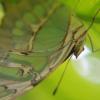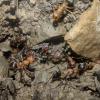

Above images Copyright © 2013 Nathanael Siders
Collection
Like the Pheidole colony I kept last year, I collected this one on May 11, 2015, under a rock. In this wooded flower bed, there was a Pheidole colony of some sort under every other rock. Some rocks housed two colonies living inches apart. In all, I saw about 3-4 different species of Pheidole, a Brachymyrmex, Solenopsis invicta, and two other distinct genera, all flipping rocks on a wooded lot.
I did not bring many collecting tools to the collection site, so I basically had a metal spoon, some small containers, and a funnel. One Pheidole dentata cf. queen and colony was almost collected, but I ended up flinging the queen at my face and losing her in the grass due to the gnats and mosquitos that were swarming around me.
I ran into luck with one of several Pheidole tysoni colonies that I found under these rocks. Only one colony had a queen visible, clinging to the rock as I flipped it—most others dispersed underground upon my intrusion. I managed to collect the queen, several hundred workers, and a large number of brood.
Known facts
Very little about this species is documented online. Some speculate that they are mostly a subterranean species, feeding on subterranean homopterans such as aphids and mealybugs. These are small ants, with 2 mm long workers, 4 mm majors, and the queen at about 6 mm (the queen is easily confused with the majors).
Unique behavioral observations
Movement
One thing that quickly impressed me about them, was the organization of movement. Upon flipping the rocks, many species would scatter in random directions—not so with P. tysoni. Instead, they moved in chains, following the leader. If I were to tilt the rock in a different direction, and the leader changed to that direction, the chain would follow. In this manner, they reminded me of a timelapse of a slime mold.
Going further, upon moving these ants into a byFormica GroTube XL formicarium by dumping them and their brood, which had inhabited a sorghum seed pod during transport, into the foraging area, they instantly began moving the brood into the nest portion of the formicarium. In stark contrast, most ants will take a significant amount of time to determine a suitable emergency nest location, organize, and move in. These ants managed to relocate their entire colony of several hundred workers and brood within 2-3 minutes of introduction—in what must be a world record for ant relocation. There are no better words to describe the organizational superiority of their nest relocation skills.
Foraging and recruitment
Experimental diets E2, left blue droplet; E4, right blue gel. Italian forest honey, top. Cockroach, far right.
In any case, with so little study on this species, especially with regard to diet (my specialty), it will be interesting determining their feeding habits. One thing I have noticed about this species, is that they do not appear to recruit heavily. The time it takes for a significant number of ants to congregate to a food source is very long—as if the collection of ants is more of random encounters, than an organized recruitment. I have observed what appear to be foraging trails, but the frequency of responding workers to such trails is very low, even if a large number eventually congregate to the food.
I'll post pictures, videos, and other observations as this moves along. They don't appear to be ill suited for captivity—however, only time will tell if they thrive.
Edited by drtrmiller, May 12 2015 - 12:28 AM.




















